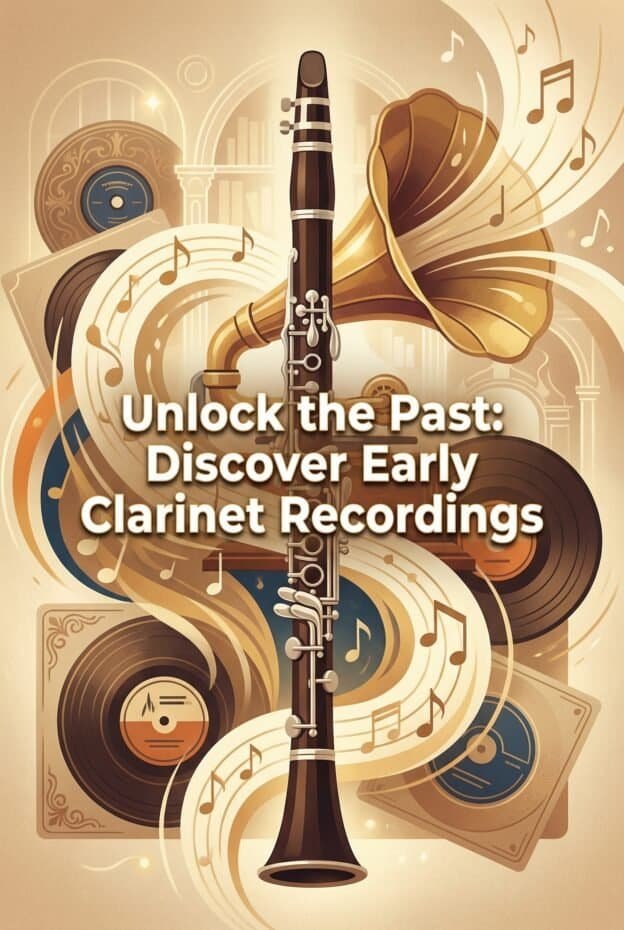Early clarinet recordings are audio documents from the late 19th and early 20th centuries that capture clarinet tone, technique, and repertoire as performed with period instruments and early recording technologies. They are important for understanding the instrument's historical sound, performance practice, and evolution.
Introduction: Why Early Clarinet Recordings Matter
Early clarinet recordings matter because they are the closest evidence we have of how clarinetists actually sounded before the modern era. Scores and method books describe style in words, but cylinders and discs preserve articulation, timing, pitch, and color in real time. For performers and scholars, they function as sonic manuscripts.
These recordings also document the transition from 19th century clarinet aesthetics to the more focused, homogenous tone of the mid 20th century. By comparing artists across decades, listeners can trace changes in vibrato, portamento, rubato, and even reed strength. They also reveal how recording technology itself shaped clarinet technique and repertoire choices.
Between roughly 1890 and 1950, commercial labels issued more than 3,000 sides featuring clarinet as solo or prominent obbligato, spanning classical, military band, klezmer, and early jazz styles.
For advanced students and professionals, early clarinet recordings offer a practical laboratory for phrasing and tone. For historians and archivists, they raise questions about cataloging, matrix numbers, and preservation formats. For curious listeners, they provide a vivid, sometimes surprising, window into the sound world that shaped 20th century clarinet playing.
Historical Context: From Cylinders to Discs (late 19th – mid 20th century)
Early clarinet recordings begin in the cylinder era of the 1890s, when Thomas Edison and others marketed wax cylinders for home phonographs. Military and municipal bands, often with prominent clarinet sections, were among the first ensembles recorded. Solo clarinet features appear sporadically, usually in popular airs and showpieces.
By the 1890s and early 1900s, Emile Berliner's flat disc format gained ground, leading to labels such as Victor, Columbia, and Gramophone & Typewriter. Clarinetists in European and American orchestras, including players like Charles Draper in Britain, began to appear on orchestral and chamber sides, sometimes in clarinet-centric repertoire such as Weber and Mozart excerpts.
The electrical recording revolution around 1925 increased usable frequency range from roughly 250-2,500 Hz to closer to 100-5,000 Hz, dramatically improving clarinet clarity on disc.
From the 1910s through the 1930s, clarinetists recorded in multiple contexts: salon ensembles, wind bands, klezmer groups, New Orleans and Chicago jazz bands, and early swing orchestras. Benny Goodman, Artie Shaw, and Jimmie Noone belong firmly to the 1930s swing and big band era, not the pre-1900 period, but their earliest sides still qualify as early clarinet recordings in a broader historical sense.
By the 1940s and early 1950s, magnetic tape and improved microphones allowed more faithful capture of clarinet nuance. Labels such as Decca, EMI, and RCA Victor documented major classical clarinetists in concerto and chamber repertoire, while small independent labels preserved regional jazz and folk clarinet traditions. This mid century period forms a bridge between acoustic-era aesthetics and modern high-fidelity expectations.
Recording Technology and Its Effect on Clarinet Sound
Recording technology shaped how clarinetists played, what they chose to record, and what listeners now hear. Acoustic recording, used until the mid 1920s, relied on a horn that funneled sound directly to a cutting stylus. Clarinetists had to stand close to the horn and adjust dynamics and articulation so the reed sound would register on the disc or cylinder.
Because the acoustic process favored midrange frequencies, clarinet tone on these records often sounds thin or nasal compared with live playing. Players sometimes exaggerated staccato and avoided extreme soft dynamics that might vanish into surface noise. Orchestral balance was distorted, so clarinet solos might be unnaturally prominent or, in some cases, barely audible.
With the advent of electrical recording around 1925, microphones and electronic amplification captured a wider frequency range and more dynamic contrast. Clarinetists could use a fuller, rounder tone and more natural phrasing. Vibrato, subtle crescendos, and color changes in the chalumeau register became easier to perceive on disc.
Early tape and high-fidelity disc formats in the 1940s and 1950s further altered expectations. Clarinetists could play with softer attacks and longer legato lines, knowing that the microphone would still capture detail. This encouraged a smoother, more continuous approach to phrasing, closer to what we now consider standard classical and jazz clarinet tone.
Typical acoustic 78 rpm discs captured roughly 2-4 minutes per side, forcing clarinetists to compress multi-movement works or select only short showpieces and excerpts for recording.
Modern listeners must remember that what we hear on early recordings is a combination of player, instrument, room, horn or microphone placement, and disc or cylinder condition. When using these recordings as stylistic models, it helps to mentally reverse some of the distortions created by the technology, especially in balance and dynamic range.
Notable Early Clarinet Artists & Landmark Recordings
Several clarinetists stand out in the early recording era for their artistry and historical importance. In Britain, Charles Draper, associated with composers like Stanford and Ireland, appears on early 20th century recordings of chamber music and orchestral works. His playing offers insight into late Victorian and Edwardian clarinet style, including portamento and flexible rubato.
In France, players from the Paris Conservatoire tradition, such as Louis Cahuzac, were documented slightly later but still within the early recording window. Cahuzac's recordings of French repertoire, including his own works, show a bright, focused tone and a controlled vibrato that contrasts with some German and British contemporaries.
On the jazz side, early recordings by New Orleans and Chicago musicians such as Johnny Dodds and Jimmie Noone in the 1920s capture a raw, vocal approach to clarinet sound. Their use of glissandi, growls, and flexible pitch became foundational for later jazz clarinetists. These sides for labels like Okeh and Vocalion are important listening for stylistic research.
Benny Goodman's earliest recordings from the late 1920s and early 1930s, including work with Ben Pollack and his own small groups, show the transition from hot dance band clarinet to the highly polished swing style that would dominate the mid 1930s. While not as early as acoustic-era sides, they document a pivotal shift in clarinet articulation and time feel.
In the classical realm, early recordings of Weber concertos, Mozart K.622 excerpts, and solo showpieces such as Bassi or Cavallini fantasies provide concrete examples of pre-war phrasing. Labels like HMV, Columbia, and early Decca preserved performances by European and American orchestral principals whose names sometimes appear only in discographies and session logs.
For klezmer and Eastern European traditions, clarinetists such as Naftule Brandwein and Dave Tarras recorded in the 1920s and 1930s for Victor and Columbia. Their sides preserve ornaments, slides, and rhythmic inflections that are difficult to reconstruct from notation alone. These recordings remain central sources for historically informed klezmer performance.
Instrument Craftsmanship and Historical Equipment
Early clarinet recordings also document the sound of historical instruments that differ significantly from modern Boehm clarinets. Late 19th and early 20th century clarinets often had smaller bores, different undercutting, and less standardized keywork. These design features affected intonation, resistance, and tonal color across the registers.
German and Austrian clarinets, often using the Oehler or related systems, produced a darker, more covered sound, especially in the chalumeau register. French Boehm instruments tended to be brighter and more flexible in the upper clarion. Listeners can often hear these differences on early recordings, even through technological limitations.
Many early clarinetists used mouthpieces with narrower tip openings and shorter facings than modern designs. Combined with harder reeds, this setup produced a focused, compact sound with quick response but less dynamic breadth. On recordings, this often translates into a clear, centered tone that projects well through surface noise.
Keywork on historical instruments also influenced recorded technique. Fewer auxiliary keys and less ergonomic layouts made some fast passages and extreme chromatic lines more awkward. Players developed alternate fingerings and hand positions that sometimes left subtle traces in articulation or intonation, audible on close listening.
Registers and cross-fingerings on period instruments
On many historical clarinets, the chalumeau register (low E to F sharp) can sound more veiled and resistant than on modern instruments. Cross-fingered notes, especially throat tones like A and B flat, may be less stable in pitch. Players compensated with embouchure adjustments and alternate fingerings, which can be heard in slight pitch shading on recordings.
The clarion register (roughly B above the staff to C above the staff) often speaks easily but may have sharper intonation tendencies on certain historical designs. Early recordings sometimes reveal clarinetists favoring specific keys or avoiding awkward note combinations that exposed these quirks. This can inform modern players who choose to perform on period instruments today.
Anatomy of Sound: Reeds, Mouthpieces, and Tone Production
The anatomy of clarinet sound on early recordings begins with reeds and mouthpieces. Many early 20th century clarinetists used cane reeds that were cut and scraped differently from modern commercial designs. Thicker blanks and harder strengths, paired with closed-tip mouthpieces, encouraged a compact, focused tone and relatively light vibrato.
Mouthpiece chamber shapes and baffle designs were generally less aggressive than some modern models. This contributed to a smoother, less edgy sound, especially in the upper clarion and altissimo. On recordings, this can make high notes sound less penetrating but often more blended with surrounding instruments.
Embouchure habits also differed. Some schools, particularly in Germany and parts of Eastern Europe, favored a slightly looser embouchure with more lip cushion, producing a warm, covered tone. French and American players often used a firmer, more forward embouchure that emphasized clarity of attack. These differences are audible in early discs and can guide stylistic choices.
Registers, tone, and intonation tendencies
- Chalumeau register: On early recordings, listen for a darker, sometimes grainy texture and occasional pitch sag on low E and F, especially on German-system instruments.
- Throat tones: A, B flat, and B natural may sound slightly unstable or color-shifted due to cross-fingerings and less refined tone-hole placement.
- Clarion register: Often the most reliable and brilliant on period instruments, with clear articulation and strong projection on disc.
Modern players studying early recordings should separate technological artifacts from genuine tone production habits. Surface noise, limited bandwidth, and microphone placement can mask subtleties. Careful comparison across multiple transfers and labels helps reveal consistent features of embouchure, reed response, and register balance.
Preservation, Archives, and Where to Listen (primary sources & catalogs)
Finding reliable, well-documented early clarinet recordings requires careful use of institutional archives and curated digital collections. The Library of Congress National Jukebox offers streaming access to thousands of acoustic-era discs from labels like Victor, with catalog information, recording dates, and matrix numbers that are important for scholarly work.
The Internet Archive hosts digitized cylinders and 78 rpm discs from collections such as the UCSB Cylinder Audio Archive and private donors. Many of these entries include label scans, take numbers, and basic metadata. For clarinetists, searching by composer, ensemble, or label often yields better results than searching by instrument alone.
Commercial discographies and label catalogs, such as Victor and Columbia numerical lists, remain important tools. They allow researchers to cross-reference take numbers, recording venues, and personnel. Some university libraries and national sound archives provide downloadable PDFs of historical catalogs that can be searched for clarinet-related repertoire.
European institutions, including the British Library Sound Archive and national libraries in France and Germany, maintain large collections of early discs and tapes. Access policies vary, but many offer on-site listening and, in some cases, low-resolution streaming for research. Contacting staff with specific matrix numbers or catalog entries often speeds the search.
Field Note (Martin Freres archive insight): In the Martin Freres historical documentation project, early 20th century catalogs and surviving instruments are cross-checked against contemporary recordings. This helps identify which clarinet models and bore designs were likely used on specific European discs, refining our understanding of recorded tone and response.
For those building personal reference libraries, high-quality reissues on CD or lossless download, produced by labels that specialize in historical transfers, often provide the best balance of sound quality and accurate speed. These editions usually document transfer equipment, equalization curves, and source discs, which is important when comparing performances across time.
How Early Recordings Inform Modern Technique and Interpretation
Early clarinet recordings can directly influence modern technique and interpretation when approached critically. Listening to phrasing, note lengths, and articulation patterns reveals how players shaped lines within the constraints of acoustic and early electrical recording. Shorter takes often led to more concentrated, speech-like phrasing that modern players can adapt for clarity.
Articulation is particularly instructive. Many early classical clarinetists used a lighter, more varied staccato, with clear differentiation between portato, mezzo-staccato, and true staccato. Jazz and klezmer players employed tongued accents, ghosted notes, and slurs across the break that are rarely notated. Transcribing these details from recordings can transform a modern player's palette.
Vibrato and pitch flexibility also emerge as key topics. Some early classical players used almost no vibrato, while others employed a narrow, fast vibrato on sustained notes. Jazz and klezmer clarinetists used flexible pitch, scoops, and slides to shape expressive contours. Understanding these practices helps modern performers avoid anachronistic uniformity in historical repertoire.
For programming, early recordings suggest repertoire that speaks well on period instruments or in historically informed performances. Short character pieces, dance movements, and salon works often come across more convincingly than long, symphonic forms when using historical setups or emulating early recording aesthetics.
Finally, early recordings teach time feel. The relationship between soloist and accompaniment, especially in rubato passages, differs from many contemporary norms. Subtle pushes and pulls, often coordinated with harmonic tension, can be heard clearly in chamber and concerto excerpts. Studying these nuances can enrich modern interpretations without turning them into museum pieces.
Maintaining and Troubleshooting Historical Clarinets and Recordings
Working with historical clarinets requires careful maintenance and respect for fragile materials. Wood can be dry, keys can be worn, and pads may be original. Before playing, have a qualified woodwind technician or conservator assess the instrument's structural integrity, including tenon fit, bore condition, and crack risk around tone holes and sockets.
Climate-controlled storage is important. Aim for stable humidity around 45-55 percent and moderate temperatures to prevent cracking or warping. Store the clarinet in its case, horizontal, with gentle support for the joints. Avoid rapid temperature changes, such as moving directly from a cold car to a warm stage.
Gentle bore cleaning with a soft, dry swab is usually safest. Avoid aggressive bore oils or solvents unless recommended by a conservator familiar with historical instruments. Corks on tenons and mouthpieces may be brittle; replace them only with reversible methods and document any changes for archival records.
Handling and basic troubleshooting for vintage clarinets
- Sticky pads: Use clean cigarette paper or pad paper to blot moisture. Do not use powders or abrasives on historical pad surfaces.
- Octave/throat key issues: If notes crack or fail to speak, check for bent key arms, weak springs, or leaks around the register vent. Do not force keywork; consult a technician.
- Cracked mouthpieces: Avoid playing on visibly cracked mouthpieces. Have a specialist evaluate whether conservation or non-playing display is more appropriate.
Preserving early recordings themselves also demands care. For physical discs, store vertically in archival sleeves, away from heat and direct sunlight. Cylinders should be housed in supportive containers that prevent warping. Handle all carriers by the edges, with clean, dry hands or gloves recommended by your archive.
Troubleshooting analogue audio issues in digitized transfers
- Surface noise: Expect hiss and crackle on 78s and cylinders. Use gentle digital noise reduction, avoiding settings that remove high-frequency clarinet overtones.
- Speed variations: Early discs were not always exactly 78 rpm. Compare pitch with known reference tones or piano parts to estimate correct playback speed.
- Wow & flutter: Slow pitch wobble may be inherent to the original recording or introduced by playback equipment. When possible, compare multiple transfers to identify the most stable version.
When in doubt, consult institutional guidelines from national sound archives or professional organizations. They provide detailed recommendations on digitization formats, such as 24-bit / 96 kHz WAV for preservation masters, and on documentation of transfer settings, which is important for future research.
Listening Guide: Key Tracks, Dates, and What to Listen For
A focused listening plan helps transform early clarinet recordings from curiosities into practical study tools. Start with a small set of representative tracks spanning acoustic, early electrical, and tape-era recordings. For each track, note the label, catalog number, recording date, and personnel if known.
For acoustic-era classical style, seek out early 20th century recordings of Weber or Mozart excerpts by European orchestras with documented clarinet principals. Listen for articulation clarity despite technological limits, and for how the clarinet balances with strings and winds around the recording horn.
For jazz, compare 1920s sides by Johnny Dodds or Jimmie Noone with early 1930s recordings by Benny Goodman. Focus on attack shapes, use of glissandi, and rhythmic placement within the ensemble. Notice how microphone technology in the electrical era allows softer attacks and more dynamic nuance.
For klezmer and folk traditions, listen to Naftule Brandwein and Dave Tarras on 1920s and 1930s discs. Pay attention to ornaments, slides into notes, and the relationship between clarinet and rhythm section. Try to sing or play back short phrases to internalize the style.
As you listen, keep a notebook or digital log with time stamps and short descriptions, such as: “1:12 – narrow, fast vibrato on sustained G” or “2:05 – portamento between written C and E.” Over time, patterns emerge that inform your own phrasing and tone choices.
Finally, compare multiple recordings of the same piece across decades. For example, contrast an acoustic-era Weber concerto excerpt with a 1940s tape-era version. Note changes in tempo, rubato, articulation, and dynamic range. This comparative approach highlights how both technology and taste evolved, guiding your decisions in performance and teaching.
Key Takeaways
- Early clarinet recordings, from cylinders to early tape, are primary sources for historical tone, articulation, and phrasing across classical, jazz, and folk traditions.
- Recording technology and instrument design jointly shaped what we hear, so modern listeners must separate technological artifacts from genuine performance habits.
- Archives such as the Library of Congress National Jukebox and the Internet Archive provide important access and metadata for research and listening.
- Careful preservation of both historical clarinets and analogue recordings protects fragile evidence that cannot be replaced once damaged.
- Systematic listening, transcription, and comparison across eras can significantly enrich modern clarinet technique, interpretation, and programming.
FAQ
What is Early Clarinet Recordings?
Early clarinet recordings are audio documents from roughly the late 19th century through the mid 20th century that feature the clarinet as solo, ensemble, or obbligato voice. They include cylinders, 78 rpm discs, and early tape, and they preserve historical clarinet tone, technique, repertoire, and performance practice.
How did early recording technology change the way clarinetists played?
Early acoustic recording forced clarinetists to adjust dynamics, articulation, and placement around the recording horn so the instrument would register clearly. Short disc durations encouraged compact phrasing and selection of brief showpieces. With electrical recording and tape, players could use wider dynamics, softer attacks, and more nuanced tone color.
Where can I listen to or download authentic early clarinet recordings?
You can hear authentic early clarinet recordings through institutional archives and curated digital collections. The Library of Congress National Jukebox, the Internet Archive, and various university sound archives host streaming and downloadable transfers of cylinders and 78s, often with detailed catalog data and label scans.
How do I preserve old clarinet recordings and what formats are safest?
Store physical discs vertically in archival sleeves, cylinders in supportive containers, and keep all carriers in a stable, cool, dry environment. For digital preservation, uncompressed formats such as 24-bit / 96 kHz WAV are preferred as preservation masters, with compressed formats like MP3 reserved for access copies and casual listening.
Can studying early recordings improve my modern clarinet playing?
Yes. Studying early recordings sharpens your awareness of articulation types, phrasing, vibrato, and time feel that are rarely captured fully in notation. By transcribing and emulating specific passages, you expand your expressive vocabulary and gain historically informed options for interpreting both standard repertoire and stylistically related new works.







